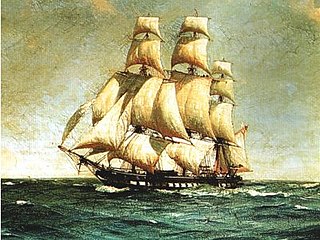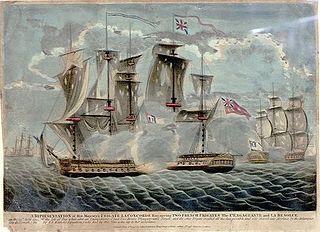
Jean-Baptiste Philibert Willaumez was a French naval officer and nobleman who served during the French Revolutionary Wars and Napoleonic Wars. Willaumez joined the French Navy at the age of 14, and proved to be a competent sailor. Having risen to the rank of pilot, he started studying navigation, attracting the attention of his superiors up to Louis XVI himself. Willaumez eventually became an officer and served under Antoine Bruni d'Entrecasteaux in his expedition to rescue Jean-François de Galaup, comte de Lapérouse and explore the Indian Ocean and Oceania.
Médée was an Iphigénie-class 32-gun frigate of the French Navy. The British captured her in 1800 and took her into service as HMS Medee, but never commissioned her into the Royal Navy, instead using her as a prison ship.

Franchise was launched in 1798 as a 40-gun Coquille-class frigate of the French Navy. The British captured her in 1803 and took her into the Royal Navy under her existing name. In the war on commerce during the Napoleonic Wars she was more protector than prize-taker, capturing many small privateers but few commercial prizes. She was also at the battle of Copenhagen. She was broken up in 1815.

Pomone was a 40-gun frigate of the French Navy, launched in 1785. The British captured her off the Île de Batz in April 1794 and incorporated her into the Royal Navy. Pomone subsequently had a relatively brief but active career in the British Navy off the Atlantic and Mediterranean coasts of France before suffering sufficient damage from hitting a rock to warrant being taken out of service and then broken up in 1803.

Néréide was a Sibylle-class, 32-gun, copper-hulled frigate of the French Navy. On 22 December 1797 HMS Phoebe captured her and she was taken into British service as HMS Nereide. The French recaptured her at the Battle of Grand Port, only to lose her again when the British took Isle de France, in 1810. After the Battle of Grand Port she was in such a poor condition that she was laid up and sold for breaking up in 1816.

Sensible was a 32-gun Magicienne-class frigate of the French Navy. The Royal Navy captured her in 1798 off Malta and took into service as HMS Sensible. She was lost in a grounding off Ceylon in 1802.

The Preneuse was a 44-gun frigate of the French Navy, lead ship of her class, designed by Raymond-Antoine Haran and built at Rochefort. She served as a commerce raider at Île de France.

HMS Pique was a 38-gun fifth rate frigate of the Royal Navy. She had formerly served with the French Navy, initially as the Fleur-de-Lys, and later as the Pique. HMS Blanche captured her in 1795 in a battle that left the Blanche's commander, Captain Robert Faulknor, dead. HMS Pique was taken into service under her only British captain, David Milne, but served for just three years with the Royal Navy before being wrecked in an engagement with the French ship Seine in 1798. The Seine had been spotted heading for a French port and Pique and another British ship gave chase. All three ships ran aground after a long and hard-fought pursuit. The arrival of a third British ship ended French resistance, but while the Seine and Jason were both refloated, attempts to save Pique failed; she bilged and had to be abandoned.
The action of 4 August 1800 was a highly unusual naval engagement that took place off the Brazilian coast during the French Revolutionary Wars. A French frigate force that had been raiding British commerce off West Africa approached and attempted to attack a convoy of valuable East Indiamen, two ships sailing for Botany Bay, and a whaler sailing for the South Seas' whale fishery. The small British ship of the line HMS Belliqueux escorted the convoy, which otherwise had to rely on the ships' individual armament to protect them from attack. Due to their large size, the East Indiamen could be mistaken for ships of the line at a distance, and the French commander Commodore Jean-François Landolphe was un-nerved when the convoy formed a line of battle. Supposing his target to be a fleet of powerful warships he turned to escape and the British commander, Captain Rowley Bulteel, immediately ordered a pursuit. To preserve the impression of warships he also ordered four of his most powerful East Indiamen to join the chase.
Infatigable was a 40-gun Valeureuse-class frigate of the French Navy, launched at Le Havre in 1799. She took part in Allemand's expedition of 1805. The British Royal Navy captured her in 1806. She was taken into the Royal Navy but never used and she was broken up in 1811.

Concorde was a 32-gun frigate of the French Navy, lead ship of her class. Built in Rochefort in 1777, she entered service with the French early in the American War of Independence and was soon in action, capturing HMS Minerva in the West Indies. She survived almost until near the end of the war when HMS Magnificent captured her in 1783. Not immediately brought into service due to the draw-down in the navy after the end of the war, Concorde underwent repairs and returned to active service with the outbreak of war with France in 1793 as the fifth-rate HMS Concorde.

Gracieuse was a 32-gun Charmante-class frigate of the French Navy. Renamed to Unité in 1793, she took part in the French Revolutionary Wars. The Royal Navy captured her in 1796 off Île d'Yeu and brought her into British service as HMS Unite. She was sold in 1802
Vésuve was an 18-gun Etna-class corvette of the French Navy, launched in 1795. She was decommissioned in 1815 and broken up in 1830.
Créole was a 40-gun frigate of the French Navy, a one-off design by Jacques-Augustin Lamothe. The French Navy loaned her to a privateer in 1797. Later, she served in the Brest squadron, took part in Ganteaume's expeditions of 1801 to Egypt, and was involved in the French acquisition of Santo Domingo and briefly detained Toussaint Louverture before he was brought to France. The 74-gun ships HMS Vanguard and HMS Cumberland captured her Santo Domingo on 30 June 1803. The Royal Navy took her into service but she foundered soon afterwards during an attempt to sail to Britain; her crew were rescued.

Vertu was a 40-gun French frigate designed by engineer Segondat. She served in Sercey's squadron in the Indian Ocean, and in Saint-Domingue. She was captured by the Royal Navy at the end of the Blockade of Saint-Domingue when the island surrendered to the British. After her capture the Navy sailed her to Britain but never commissioned her, and finally sold her in 1810.
Courageuse was a 12-pounder Concorde class frigate of the French Navy. She was launched in 1778. The British captured her in 1799 and thereafter used her as a receiving ship or prison hulk at Malta before breaking her up in 1802.
The action of 18 June 1799 was a naval engagement of the French Revolutionary Wars fought off Toulon in the wake of the Mediterranean campaign of 1798. A frigate squadron under Rear-admiral Perrée, returning to Toulon from Syria, met a 30-ship British fleet under Lord Keith. Three ships of the line and two frigates detached from the British squadron, and a 28-hour running battle ensued. When the British ships overhauled them, the French frigates and brigs had no choice but to surrender, given their opponents' overwhelming strength.
Salamine was originally the Spanish Navy's Infante 18-gun brig, built in 1787 at Cadiz. The French Navy captured her at Toulon in December 1793 and recommissioned her; they renamed her on 10 May 1798 as Salamine, for the battle of Salamis. On 18 June 1799, HMS Emerald captured her and she was brought into Royal Navy service as HMS Salamine. She served briefly in the Mediterranean, where she captured two French privateers and several merchant vessels before the Royal Navy sold her at Malta in 1802, after the Treaty of Amiens ended the war with France.

HMS Proserpine was a 32-gun Amphion-class frigate built for the Royal Navy during the Napoleonic Wars. The French Navy captured her off Toulon about a year after her commissioning and took her into service as Proserpine. She served in various capacities such as a frigate, troopship, hospital ship, and prison hulk until 1865.

HMS Barbuda was commissioned into the Royal Navy in 1780 after having briefly served as an American privateer. Barbuda was one of the two sloops that captured Demerara and Essequibo in 1781, but the French Navy captured her there in 1782 and took her into service as Barboude. The French Navy sold her to private owners in 1786, and she served briefly as a privateer in early 1793 before the French Navy purchased her again and named her Légère. She served them until mid-1796 when the Royal Navy captured her and took her into service as HMS Legere. She was wrecked off the coast of Colombia, without loss of life, in February 1801.











